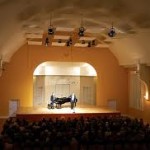
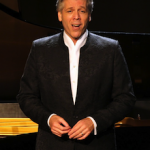 The field of classical song, recital song, solo song, or the most common expression, art song performance is seldom given the attention that the field deserves. Though the star of this website is certainly Lotte Lehmann, her co-star is the world of Lieder, mélodie, and art song. (At the bottom of this page I try to list all the ways that this genre is called!)
The field of classical song, recital song, solo song, or the most common expression, art song performance is seldom given the attention that the field deserves. Though the star of this website is certainly Lotte Lehmann, her co-star is the world of Lieder, mélodie, and art song. (At the bottom of this page I try to list all the ways that this genre is called!)
In a February 26, 2013 review, Steven Winn wrote: As if his masterly voice, elegant stage presence, striking good looks, and a peerless accompanist weren’t persuasive enough, baritone Thomas Hampson offered an eloquent tribute to the power of the art song near the end of his San Francisco Performances recital Tuesday at Herbst Theatre. “It is the blueprint of who we are as human beings,” he said. “Why everyone doesn’t embrace it, I don’t know.” Hampson would win the office of Lieder Ambassador, if such a thing existed, in a landslide. You can find the good work of his foundation at Hampsong.
Another good site (besides right here!) to read about art song is Artsong Update. Find original texts and translations at The Lied, Art Song, and Choral Texts, locate sheet music at Art Song Central, learn about Russian Art Song, buy songs in almost any language imaginable at Classical Vocal Reprints, and there are amazingly deep resources about Swedish romanser at the Art Song Project. Keeping the art song recital alive is the Floristan Recital Project and the Art Song Preservation Society, now in its tenth year.
Let’s work together to assemble master classes by as many major artists as possible. This can then be a site that students can use to great benefit. I’m doing what I can to gather  Lehmann master classes. You can hear the results in the Apple iBooks: Lotte Lehmann & Her Legacy Volumes III-V or here: Art Song; Song Cycles; or Arias and Opera Scenes. Please send me what you have of her, as well as singers and pianists that provide good instruction. I’ll begin with a basic intro that Thomas Hampson provided. Then from the audio, you can view Hampson teaching the Berlioz Spectre de la rose. There are other YouTube master classes by Hampson, Thomas Quasthoff, Dietrich Fischer-Dieskau, Renée Fleming, Brigitte Fassbänder, Christoph Prégardien, etc. And go to Master Class Media Foundation for many more.
Lehmann master classes. You can hear the results in the Apple iBooks: Lotte Lehmann & Her Legacy Volumes III-V or here: Art Song; Song Cycles; or Arias and Opera Scenes. Please send me what you have of her, as well as singers and pianists that provide good instruction. I’ll begin with a basic intro that Thomas Hampson provided. Then from the audio, you can view Hampson teaching the Berlioz Spectre de la rose. There are other YouTube master classes by Hampson, Thomas Quasthoff, Dietrich Fischer-Dieskau, Renée Fleming, Brigitte Fassbänder, Christoph Prégardien, etc. And go to Master Class Media Foundation for many more.
I have produced various vehicles to further art song interest. The excellent singers Jordan Shanahan, Shelley Brenneman and Mary Chesnut-Hicks sang and acted art songs into small scenarios. Beebe Freitas was the pianist. The whole film lasts 15 minutes and is called Three American Art Songs.
Another idea I have is for art song to be used in foreign language labs. But anyone can enjoy hearing an art song, watching the images that the poetry describes and reading the poetry and translation as the song goes along. I hope you will enjoy LyricLanguages when I once again am able to develop it. The early project needs serious upgrading.
The World of Song Award is another way there to celebrate the great songs and their performance. Initiated first under the auspices of the Lotte Lehmann Foundation in 2001, I re-established it as of 2013. But its value had not been noticed by the media, so it was discontinued in 2018. You can read about former winners and their reactions to the award: World of Song Award
You may want to read a page I’ve written about art song using Lehmann’s experience in the field as its basis. I try to define various aspects of art song with actual examples.
Another area that interests me is the use of supratitles for art song, the way they’re used for opera. I have some information on how to accomplish that on a separate page.
 I like to have fun with art song. (See also the silliness at the bottom of this page.) Can you name the four sopranos found in this conflated version of Schubert’s Gretchen am Spinnrade? Or can you guess the two baritones in Feuerreiter by Wolf? Just send me the singers and I’ll post the winners’ names. Or identify the singers in these three versions of Polo: Polo 1 Polo 2 Polo 3 In any of these games, your opinions about the various singers, their styles, voices, and interpretive choices, are all of interest to others who view this site. Have fun! Go to the translation page for the words of some of these songs.
I like to have fun with art song. (See also the silliness at the bottom of this page.) Can you name the four sopranos found in this conflated version of Schubert’s Gretchen am Spinnrade? Or can you guess the two baritones in Feuerreiter by Wolf? Just send me the singers and I’ll post the winners’ names. Or identify the singers in these three versions of Polo: Polo 1 Polo 2 Polo 3 In any of these games, your opinions about the various singers, their styles, voices, and interpretive choices, are all of interest to others who view this site. Have fun! Go to the translation page for the words of some of these songs.
I produced Great Songs, a one-hour program of art songs for Hawaii Public Radio for 20 years. Here are some programs for you to sample or enjoy complete: Lotte Lehmann; Words On The Wind; Composer Accompanists; Seniors Sing; Golden Age Singers; Scandanavian Songs.
Now, since November 2011, I have a new radio program called Singing and other Sins. It’s still mainly art song, but includes instrumental, choral and opera as appropriate. You can sample those programs in the Singing And Other Sins archive.
Perhaps you already are convinced of the beauty and importance of art song, but I like to quote the big guys/gals and here’s what the composer Camile Saint-Säens wrote in 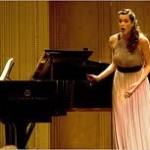 reference to poetry and music: “…these two arts…are made to truly supplement each other. Do not the rhythmic and sonorous passages of the finest poetry naturally call for song to then set them off? Singing is but a better method of declaiming it! Singing must emerge from poetry as a kind of blossoming.”
reference to poetry and music: “…these two arts…are made to truly supplement each other. Do not the rhythmic and sonorous passages of the finest poetry naturally call for song to then set them off? Singing is but a better method of declaiming it! Singing must emerge from poetry as a kind of blossoming.”
I’ll try to include other commentary on the field of art song, but let’s get back to music!
Besides Lehmann, there are many singers who have added to the glory of art song. In the recent past names such as Gérard Souzay, Hermann Prey and Dietrich Fischer-Dieskau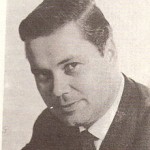 spring to mind. Let’s hear Fischer-Dieskau sing Beethoven’s Mailied. Prey sings Das Fischermädchen by Schubert. I’ve been asked to add Robert Schumann’s Widmung, which I know you’ll enjoy in this performance by Prey. Finally from these magnificent baritones, we’ll sample
spring to mind. Let’s hear Fischer-Dieskau sing Beethoven’s Mailied. Prey sings Das Fischermädchen by Schubert. I’ve been asked to add Robert Schumann’s Widmung, which I know you’ll enjoy in this performance by Prey. Finally from these magnificent baritones, we’ll sample  Souzay in Duparc’s Phidyle. One of the singers of this period whose voice and interpretation always seems just right to me is Victoria de los Angeles, who sings Callajero in LyricLanguages mentioned above. Another great singer who excelled in Lieder performance and recordings of the 1960s was Elisabeth Schwarzkopf.
Souzay in Duparc’s Phidyle. One of the singers of this period whose voice and interpretation always seems just right to me is Victoria de los Angeles, who sings Callajero in LyricLanguages mentioned above. Another great singer who excelled in Lieder performance and recordings of the 1960s was Elisabeth Schwarzkopf. 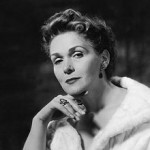 Just listen to the care that she takes with every aspect of Die Nacht by Richard Strauss. Some people feel that she’s too conscious of what she’s doing, not spontaneous enough. That has also been a criticism leveled against Elly Ameling, who also made an excellent career in Lieder, whereas the others mentioned above also sang opera (Souzay to a lesser extent). Just listen to the ease with
Just listen to the care that she takes with every aspect of Die Nacht by Richard Strauss. Some people feel that she’s too conscious of what she’s doing, not spontaneous enough. That has also been a criticism leveled against Elly Ameling, who also made an excellent career in Lieder, whereas the others mentioned above also sang opera (Souzay to a lesser extent). Just listen to the ease with 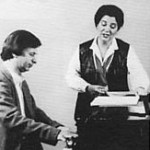 which Ameling sings Fauré’s Au bord de l’eau. So far I haven’t mentioned a tenor, but I greatly admire the huge range of singing in both opera and song of Nicolai Gedda that also ranked at the top of critical and public appreciation during the 1960s and after. A Gedda recording that I return to with admiration is his Rachmaninoff Spring Waters. This was a rich period in the world’s recorded song history. Witness Janet Baker in Munroe’s My lovely Celia. This group of singers included Jan DeGaetani whose performance of Stephen Foster’s Beautiful Child of Song makes this light song sound like a great art song. There is such a treasure of excellent recordings left behind by these wonderful singers, it strikes me as a shame that the field and the profound work done in it receives so little attention and appreciation.
which Ameling sings Fauré’s Au bord de l’eau. So far I haven’t mentioned a tenor, but I greatly admire the huge range of singing in both opera and song of Nicolai Gedda that also ranked at the top of critical and public appreciation during the 1960s and after. A Gedda recording that I return to with admiration is his Rachmaninoff Spring Waters. This was a rich period in the world’s recorded song history. Witness Janet Baker in Munroe’s My lovely Celia. This group of singers included Jan DeGaetani whose performance of Stephen Foster’s Beautiful Child of Song makes this light song sound like a great art song. There is such a treasure of excellent recordings left behind by these wonderful singers, it strikes me as a shame that the field and the profound work done in it receives so little attention and appreciation.
But are there good singers from our own time? Yes, indeed! Matthias Goerne, springs readily to mind. His dark, velvety voice is quickly recognizable and one also expects deep, probing interpretations even in a light song such as Schubert’s Frühlingssehnsucht “live” from London’s Wigmore Hall. An active mezzo soprano of our own time is Bernarda Fink who sings Guastavino’s La rosa y el sauce with tenderness and simplicity. The mezzo soprano field has many successful singers who appear in both opera and song. Frederica von Stade is one who makes the cross-over easy and often. Though especially important in the field of mélodie, more recently von Stade has sung the works of the American composer/pianist Jake Heggie: Paper Wings. Another singer who has both a good voice and knows both style and interpretation is the Canadian baritone Gerald Finley who you can hear in one of the Don Quichotte songs of Ravel: Chanson Romanesque. The American Thomas Hampson sings Lieder, but has an especial affinity for American songs such as Copland’s setting of Long Time Ago. We do have a lot of good baritones and one of the best is the Welsh Bryn Terfel  whose Linden Lea by Vaughan Williams is a real charmer. At the same contest that chose Terfel as the song winner, Dmitri Hvorostovsky won the overall prize. Listen to this Tchaikowsky song: Amid the Din of the Ball. If you have a friend who thinks he/she doesn’t like Lieder, have her/him listen to the following 1:45 of pure heaven performed by Stephan Genz: Du bist wie eine Blume (You are like a flower) by Schumann. An American soprano who has been singing beautifully for decades is Dawn Upshaw. I don’t think anyone sings Canteloube’s Baïlèro better. And how can I forget America’s prima donna, Renée Fleming? Listen to the beauty she brings to Rachmaninoff’s Zdes’ khorosho (How nice it is here). The English Mark Padmore has a tenor voice perfectly suited to Dowland’s Away With These Self-Loving Lads. There’s no contralto in my list so far! I can quickly correct that with this performance of Mussorgky’s Serenada by Ewa Podles from his Songs and Dances of Death from a live recording made at Wigmore Hall with Garrick Ohlsson. I’ll end this paragraph with a wonderful recording by Thomas Quastoff with Justus Zehen: Schubert’s Wohin. All of these singers and their pianists deserve whole websites to themselves, and such can be found!
whose Linden Lea by Vaughan Williams is a real charmer. At the same contest that chose Terfel as the song winner, Dmitri Hvorostovsky won the overall prize. Listen to this Tchaikowsky song: Amid the Din of the Ball. If you have a friend who thinks he/she doesn’t like Lieder, have her/him listen to the following 1:45 of pure heaven performed by Stephan Genz: Du bist wie eine Blume (You are like a flower) by Schumann. An American soprano who has been singing beautifully for decades is Dawn Upshaw. I don’t think anyone sings Canteloube’s Baïlèro better. And how can I forget America’s prima donna, Renée Fleming? Listen to the beauty she brings to Rachmaninoff’s Zdes’ khorosho (How nice it is here). The English Mark Padmore has a tenor voice perfectly suited to Dowland’s Away With These Self-Loving Lads. There’s no contralto in my list so far! I can quickly correct that with this performance of Mussorgky’s Serenada by Ewa Podles from his Songs and Dances of Death from a live recording made at Wigmore Hall with Garrick Ohlsson. I’ll end this paragraph with a wonderful recording by Thomas Quastoff with Justus Zehen: Schubert’s Wohin. All of these singers and their pianists deserve whole websites to themselves, and such can be found!
In the 1970s and 80s, one of my favorite sopranos was the late Arleen Auger. Just listen to the lovely sound she pours into the Obradors song Del Cabello más sutil. Anne Sofie von Otter has been singing for decades and still sounds fine. Listen to this song of her homeland, Sweden, by Wilhelm Peterson-Berger, Nothing is Like the Time of Waiting. Though she’s not an active singer now, Jessye Norman ranked until just a few years ago as one of the all-time best singers, for me, especially in art song. 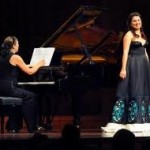 She could bring to life mélodie, spirituals, and just listen to the sheer joy of the act of singing one hears in her performance of Widmung by Schumann. One of the great prima donnas of the recent past, Leontine Price was best known for opera. She did, however, also sing and record songs such as Schumann’s Er ist’s.
She could bring to life mélodie, spirituals, and just listen to the sheer joy of the act of singing one hears in her performance of Widmung by Schumann. One of the great prima donnas of the recent past, Leontine Price was best known for opera. She did, however, also sing and record songs such as Schumann’s Er ist’s.
I’ve been writing about the singers, but you know as well as I do that they couldn’t be doing these impressive things without their pianists. In the Widmung above the excellent pianist was the English Geoffrey Parsons. Another English pianist who almost defined the art of song accompaniment in his time was 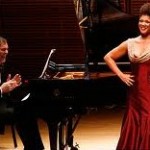 Gerald Moore, who played for Fischer-Dieskau in the Beethoven example and for de los Angeles in the LyricLanguages song. The American Dalton Baldwin played for Ameling and Souzay above. Another American, pianist Leonard Hokanson played for Prey in Das Fischermädchen.
Gerald Moore, who played for Fischer-Dieskau in the Beethoven example and for de los Angeles in the LyricLanguages song. The American Dalton Baldwin played for Ameling and Souzay above. Another American, pianist Leonard Hokanson played for Prey in Das Fischermädchen.
Here are some singers who never had a great, beautiful voice, but were respected for what they did with a song. Certainly, Hugues Cuénod falls in that category. Just listen to the style and understanding that he brings to these Poulenc songs, with the composer at the piano, recorded in December, 1953. 1. “A sa guitare” 2. “Chanson d’Orkenise” 3. “La Grenouillère” 4. “Voyage à Paris” 5. “Bleuet” 6. “Avant le cinéma” Hugues Cuénod sings Poulenc with Poulenc!. The same identification with the music of Poulenc can be heard in Pierre Bernac’s singing. Many of the composer’s songs were written with him in mind. The same can be said for the connection between Peter Pears and Benjamin Britten. Again, the voice may not be the lushest, most beautiful, but we enjoy the performance because of the interpretation and deep connection to the poetry and music. One of the light voices that found both song and oratorio comfortable is Isobel Baillie. Her 1943 recording of Arne’s Where the Bee Sucks with Gerald Moore shows how 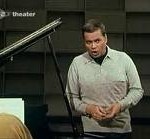 comfortable she is in this idiom. Check out other singers whose voices were not known for power or lushness, but were often chosen by the composers of the time for their songs. Claire Croiza, Madeleine Grey, Charles Panzéra, Jane Bathori and even the composer/tenor/pianist Reynaldo Hahn, who recorded his own songs. Though Erna Berger was a coloratura soprano who had a successful opera career, I believe she will be best remembered for her song recordings. Ninon Vallin, Conchita Supervia, Maggie Teyte, are just some of the sopranos of the early 20th century who left behind a large number of superb song recordings.
comfortable she is in this idiom. Check out other singers whose voices were not known for power or lushness, but were often chosen by the composers of the time for their songs. Claire Croiza, Madeleine Grey, Charles Panzéra, Jane Bathori and even the composer/tenor/pianist Reynaldo Hahn, who recorded his own songs. Though Erna Berger was a coloratura soprano who had a successful opera career, I believe she will be best remembered for her song recordings. Ninon Vallin, Conchita Supervia, Maggie Teyte, are just some of the sopranos of the early 20th century who left behind a large number of superb song recordings.
One question that I hear constantly is: Sure there were great classical songs, but what about our own time? Is anyone writing good art songs today?
The answer is a very strong YES, followed right now by a few examples from the NMC Songbook released in 2009. Alison Bauld’s Titania’s Song, Joe Duddell’s Cease Sorrow Now, Julian Philips’ Blist’s Hill, John White’s Houses And Gardens In The Heart Of England, Philip Cashian’s Daisy’s Song, and Anthony Powers’ Shining Plain
If you go to Amazon or another provider of music, you can still buy this set of wonderful new songs, all written by composers of Britain in the 21st century, well recorded and beautifully sung.
Dan Welcher, an American composer who has written many art songs, sent the following song from his set of eight Personal Ads from 2009; four for tenor and four for soprano. The texts are all sonnets, so these aren’t really cabaret songs—just earthy art songs. The text follows.
I hope to find an aproned girl in heels, seamed stockings, small cap pinned neatly in her hair—for fun and pleasure. A twenty-ish au pair who’ll tie me up and dust me, serve me meals, who sprinkles “C’est la vie” and “S’il vous plait,” in casual conversation. In bed I’ll be “Mon cher”—make her cry: “Mon Dieu!” and “Oui!” A lively, naughty sort who likes to play and has an accent—prefer short netted hair, big-breasted, non-smoking, autocratic-type who’ll order me around. Like camembert and brie I’m fifty, rich, clean, and ripe for anything you want. I’ll pleasure you and spoil you. Make my fantasy come true.
So far the art songs that I’ve considered are for voice and piano. But there are many wonderful examples that include a few 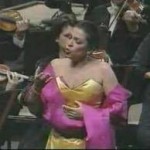 various instruments or a whole orchestra. Let’s hear Kathleen Ferrier with the Vienna Philharmonic conducted by Bruno Walter in a Mahler song: Rückertlieder – Ich atmet’ einen linden Duft. Not all songs that we hear with orchestral accompaniment were written that way by their composers. For instance, of Wagner’s five Wesendonk Lieder, only Träume was orchestrated by the master. Let’s sample that in a 1956 recording that Kirsten Flagstad recorded with the Vienna Philharmonic, Hans Knappertsbusch, conducting. Träume
various instruments or a whole orchestra. Let’s hear Kathleen Ferrier with the Vienna Philharmonic conducted by Bruno Walter in a Mahler song: Rückertlieder – Ich atmet’ einen linden Duft. Not all songs that we hear with orchestral accompaniment were written that way by their composers. For instance, of Wagner’s five Wesendonk Lieder, only Träume was orchestrated by the master. Let’s sample that in a 1956 recording that Kirsten Flagstad recorded with the Vienna Philharmonic, Hans Knappertsbusch, conducting. Träume
There are wonderful festivals devoted to art song, such as SongFest. You can hear/view some of the singers as well as interviews with some of the faculty, which includes John Musto, Martin Katz, Amy Burton, Roger Vignoles, Graham Johnson, Jake Heggie, Victoria Kirsch, Melanie Emelio, Paul Sperry, etc., at Getting to know SongFest. Our own Hawaii Performing Arts Festival on the Big Island of Hawaii offers excellent training in art song. Some of the faculty include: Val Underwood, Juliana Gondek, Jennifer McGregor, etc.
Now, with no relation to the songs above, I’ll try to list the various ways that art song is written and called. Let’s begin with artsong, then art-song, solo song, concert song, classical song, (English); kunst lied, Lied, (German); mélodie, (French); canciones, canciones liricas, canciones de concierto, (Spanish); canzoni, romanza (Italian); romanser (Swedish); melodi (Danish); (help me by submitting your own discoveries!).
Finally, don’t forget that art song is a perfect target for humor. It has a tendency to seem pretentious and pompous. So the  comedians have a ball. Dudley Moore’s Fauré and Erlkönig is an example. I also like what Tom Lehrer, a fan of classical music and of Lotte Lehmann, does. Here’s his Poisoning Pidgeons in the Park and Alma. Monty Python’s Never Be Rude to an Arab has something to insult everyone. Peter Ustinov is the orchestra, soprano and recitative, and though not art song, this is his Mozart. Elsa Lanchester always makes me laugh and her Ladies’ Bar is no exception. Cathy Berberian’s Dance Macabre is actually well sung, but in addition she has so much fun with it. Her takeoff of modern songs is delightful: Stripsody. And though their spoof is of popular song, Jonathan & Darlene Edwards (really Paul Weston and Jo Stafford), nothing can beat the “almost right note” and “too many beats in a phrase” of The Last Time I Saw Paris.
comedians have a ball. Dudley Moore’s Fauré and Erlkönig is an example. I also like what Tom Lehrer, a fan of classical music and of Lotte Lehmann, does. Here’s his Poisoning Pidgeons in the Park and Alma. Monty Python’s Never Be Rude to an Arab has something to insult everyone. Peter Ustinov is the orchestra, soprano and recitative, and though not art song, this is his Mozart. Elsa Lanchester always makes me laugh and her Ladies’ Bar is no exception. Cathy Berberian’s Dance Macabre is actually well sung, but in addition she has so much fun with it. Her takeoff of modern songs is delightful: Stripsody. And though their spoof is of popular song, Jonathan & Darlene Edwards (really Paul Weston and Jo Stafford), nothing can beat the “almost right note” and “too many beats in a phrase” of The Last Time I Saw Paris.
On 18 May 2012 the world of the Lied lost one of it most illustrious members, when it was announced that Dietrich Fischer-Dieskau passed away. I have compiled his obituaries on a page dedicated to him.
